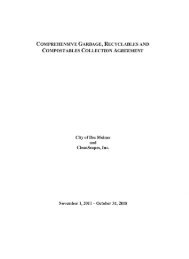CITY OF DES MOINES SHORELINE MASTER PROGRAM
CITY OF DES MOINES SHORELINE MASTER PROGRAM
CITY OF DES MOINES SHORELINE MASTER PROGRAM
Create successful ePaper yourself
Turn your PDF publications into a flip-book with our unique Google optimized e-Paper software.
Des Moines Shoreline Master Program<br />
percent), stormwater (29 percent)) and state agency (e.g., Ecology, WDFW, WSU Extension,<br />
etc.). The habitat restoration funds would be the best fit for opportunities in Des Moines.<br />
4.6.2 Puget Sound Nearshore Project/Partnership<br />
The U.S. Army Corps of Engineers and the Washington State Department of Fish and Wildlife<br />
entered into a 50/50 cost share agreement in 2002 to initiate a general investigation study. In<br />
coordination with several other agencies and organizations, the project has allowed engineers<br />
and scientists to begin to assess and identify restoration goals, work towards protection actions,<br />
and develop criteria to set priorities and develop projects in the Puget Sound nearshore<br />
environment (PSNP, 2002). To date, these efforts have resulted in technical studies and<br />
technical reports providing guidance for development of restoration projects (PSNP, 2004a,<br />
2004b), but not on-the-ground projects.<br />
4.6.3 Salmon Recovery Funding Board<br />
With the listing of salmonid species under the Endangered Species Act in 1999, the Legislature<br />
created the Salmon Recovery Funding Board (SRFB). Composed of citizens appointed by the<br />
Governor and five state agency directors, the Board provides grant funds to protect or restore<br />
salmon habitat and assist related activities. It works closely with local watershed groups and has<br />
helped finance over 500 projects. The Salmon Recovery Funding Board awarded $7.1 million<br />
during the first five funding cycles for salmon habitat protection, restoration, and assessment<br />
projects in the Green/Duwamish and Central Puget Sound Watershed (WRIA 9). These grants<br />
build on other funding sources such as the King County Conservation District and Waterways<br />
2000. The two site-specific opportunities in Des Moines (pocket estuary restoration at the<br />
mouths of Massey and McSorely Creeks; described above) that have been identified in the<br />
WRIA 9 Salmon Habitat Plan are good candidates and have the greatest likelihood of receiving<br />
SRFB funding.<br />
4.6.4 King County Conservation District<br />
The King Conservation District (KCD) is a non-regulatory natural resources assistance agency<br />
founded in 1949. The Conservation District is authorized by the State of Washington and guided<br />
by the Washington State Conservation Commission. The District promotes conservation through<br />
demonstration projects, educational events, technical assistance, and, in some cases, providing or<br />
pointing the way to funds that may be available for projects. The WRIA 9 Forum allocates<br />
approximately $634,000 in King Conservation District funds annually to support habitat<br />
protection and restoration projects, stewardship projects and programs, and essential technical<br />
assessments. The money comes from a county-wide $5 per parcel assessment that funds the<br />
activities of the King Conservation District as well as projects through other watershed forums in<br />
King County. Beginning in 2005, the highest priority for WRIA 9 KCD funding includes<br />
projects and programs that are informed by the watershed Habitat Plan and the Strategic<br />
Assessment, such as the pocket estuary restoration projects at the mouths of Massey and<br />
McSorely Creeks in Des Moines.<br />
Department of Ecology approval effective November 1, 2010<br />
44 Adopted by City of Des Moines Ordinance No. 1502



